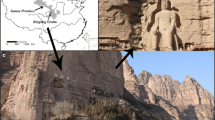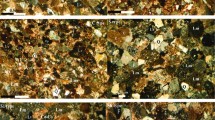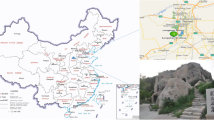Abstract
Historic sandstone structures carry an inheritance, or a ‘memory’, of past stresses that the stone has undergone since its placement in a façade. This inheritance, which conditions present day performance, may be made up of long-term exposure to a combination of low magnitude background environmental factors (for example, salt weathering, temperature and moisture cycling) and, superimposed upon these, less frequent but potentially high magnitude events or ‘exceptional’ factors (for example, lime rendering, severe frost events, fire). The impact of complex histories on the decay pathways of historic sandstone is not clearly understood, but this paper seeks to improve that understanding through the use of a laboratory ‘process combination’ study. Blocks of quartz sandstone (Peakmoor, from NW England) were divided into subsets that experienced different histories (lime rendering and removal, fire and freeze–thaw cycles in isolation and combination) that reflected the event timeline of a real medieval sandstone monument in NE Ireland, Bonamargy Friary (McCabe et al. 2006b). These subsets were then subject to salt weathering cycles using a 10% salt solution of NaCl and MgSO4 that represents the ‘every-day’ stress environment of, for example, sandstone structures in coastal, or polluted urban, location. Block response to salt weathering was monitored by collecting, drying and weighing the debris that was released as blocks were immersed in the salt solution at the beginning of each cycle. The results illustrate the complexity of the stone decay system, showing that seemingly small variations in stress history can produce divergent response to salt weathering cycles. Applied to real-world historic sandstone structures, this concept may help to explain the spatial and temporal variability of sandstone response to background environmental factors on a single façade, and encourage conservators to include the role of stress inheritance when selecting and implementing conservation strategies.





Similar content being viewed by others
References
Allison RJ, Bristow GE (1999) The effects of fire on rock weathering: some further considerations of laboratory experimental simulation. Earth Surf Processes Landforms 24:707–713
Allison RJ, Goudie AS (1994) The effects of fire on rock weathering: an experimental study. In: Robinson DA, Williams RBG (eds) Rock weathering and landform evolution. Wiley, Chichester, pp. 41–56
Blackwelder E (1926) Fire as an agent in rock weathering. J Geol 35:134–140
Brunsden D (2001) A critical assessment of the sensitivity concept in geomorphology. Catena 42:99–123
Chakrabarti B, Yates T, Lewry A (1996) Effects of fire damage on natural stonework in buildings. Construction Build Mater 10(7):539–544
COST C17 (2001) Memorandum of understanding for the implementation of a European Concerted Research Action designated as COST C17 Built Heritage: fire loss to historic buildings
Emery K (1944) Brush fires and rock exfoliation. Am J Sci 242:506–508
Gomez-Heras M (2006) Procesos y formas de deterioro termico en piedra natural del patrimonio arquitectonico. Editorial Complutense, Madrid. ISBN 84-669-2801-4
Gomez-Heras M, Varas MJ, Alvarez de Buergo M, Fort R (2004) Characterization of changes in matrix of sandstones affected by historical fires. In: Kwiatkowski D, Lofvendahl R (eds) Proceedings of the 10th International congress on deterioration and conservation of stone, Stockholm, 2004, pp. 561–568. ICOMOS, Sweden
Gomez-Heras M, Alvarez de Buergo M, Fort R, Hajpal M, Török A, Varas MJ (2006) Evolution of porosity in Hungarian building stones after simulated burning. In: Fort R, Alvarez de Buergo M, Gomez-Heras M, Vazquez-Calvo C (eds) Heritage, weathering and conservation. Taylor Francis Group, London, pp. 513–519
Goudie AS, Viles HA (1997) Salt weathering hazards. Wiley, Chichester
Goudie AS, Allison RJ, McLaren SJ (1992) The relations between modulus of elasticity and temperature in the context of the experimental simulation of rock weathering by fire. Earth Surf Processes Landforms 17:605–615
Hajpal M, Török A (2004) Mineralogical and colour changes of quartz sandstones by heat. Environ Geol 46:311–322
McCabe S, Smith BJ, Warke PA (2006a) Calcium loading of building sandstones by lime rendering: implications for decay. In: Fort R, Alvarez de Buergo M, Gomez-Heras M, Vazquez-Calvo C (eds) Heritage, weathering and conservation. Taylor Francis Group, London, pp. 177–182
McCabe S, Smith BJ, Warke PA (2006b) A legacy of mistreatment: understanding the decay of medieval sandstones in NE Ireland. Build Environ (in press)
McGreevy JP (1982) Some field and laboratory investigations of rock weathering, with particular reference to frost shattering and salt weathering. PhD thesis, Queen’s University Belfast, Belfast
Nesje A, Olaf Dahl S (2003) The ‘Little Ice Age’—only temperature? Holocene 13(1):139–145
Obojes U, Tropper P, Mirwald PW, Saxer A (2006) The effects of fire and heat on natural building stones: first results from the Groden Sandstone. In: Fort R, Alvarez de Buergo M, Gomez-Heras M, Vazquez-Calvo C (eds) Heritage, weathering and conservation. Taylor Francis Group, London, pp. 521–524
Schaffer RJ (1932) The weathering of natural building stones. Donhead, London (facsimile)
Smith BJ (1996) Scale problems in the interpretation of urban stone decay. In: Smith BJ, Warke PA (eds) Processes of urban stone decay. Donhead, London, pp. 3–18
Smith BJ, Turkington AV, Curran JM (2001) Calcium loading of quartz sandstones during construction: implications for future decay. Earth Surf Processes Landforms 26:877–883
Smith BJ, Warke PA, McGreevy JP, Kane HL (2005) Salt-weathering simulations under hot desert conditions: agents of enlightenment or perpetuators of preconceptions? Geomorphology 67:211–227
Turkington AV, Smith BJ (2004) Interpreting spatial complexity of decay features on a sandstone wall: St. Matthews Church, Belfast. In: Smith BJ, Turkington AV (eds) Stone decay: its causes and controls. Donhead, London, pp. 149–166
Viles HA (2002) Implications of future climate change for stone deterioration. In: Seigesmund S, Weiss T, Vollbrecht A (eds) Natural stone, weathering phenomenon, conservation strategies and case studies. Special Publications 205. Geological Society, London, pp. 407–418
Warke PA (1994) Inheritance effects in the weathering of debris under hot arid conditions. PhD thesis, Queen’s University Belfast, Belfast
Warke PA (1996) Inheritance effects in building stone decay. In: Smith BJ, Warke PA (eds) Processes of urban stone decay. Donhead, London, pp. 32–43
Warke PA, McKinley J, Smith BJ (2006) Variable weathering response in sandstone: factors controlling decay sequences. Earth Surf Processes Landforms 31:715–735
Williams RBG, Robinson DA (2001) Experimental frost weathering of sandstone by various combinations of salts. Earth Surf Processes Landforms 26:811–818
Acknowledgments
Thanks to Gill Alexander in the Cartographic Department of the School of Geography, Archaeology and Palaeoecology, Queen’s University Belfast, for the preparation of figures. This research was undertaken as part of a Department of Employment and Learning (DEL) funded postgraduate award.
Author information
Authors and Affiliations
Corresponding author
Rights and permissions
About this article
Cite this article
McCabe, S., Smith, B.J. & Warke, P.A. Preliminary observations on the impact of complex stress histories on sandstone response to salt weathering: laboratory simulations of process combinations. Environ Geol 52, 251–258 (2007). https://doi.org/10.1007/s00254-006-0531-7
Received:
Accepted:
Published:
Issue Date:
DOI: https://doi.org/10.1007/s00254-006-0531-7




